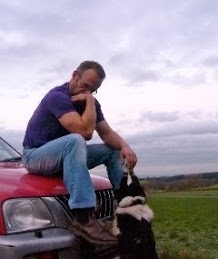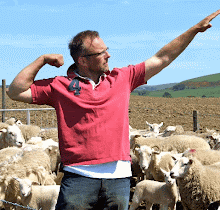A huge proportion of my followers (50% of all two of them) have requested more detail on the sheep that I’ve come across here. Always keen to respond quickly to feedback, I have waited a week and finally got round to this - this ones for you Timothy....

Damarra and Dorper - wool shedders. The Damarra is a fat tailed sheep that isn’t too popular with processors as a pure bred. It is smaller than the dorper, hardy and has the ability for polyoestrus (Sp?) lambing (ie twice a year) I hope I’ve attached a photo of some cross Damarras; the Dorper - I saw mostly white faced - is a big sheep with a good carcass. A cross of the two is common with Garry Hannigan really pleased with a Dorper (50%); Damarra (25%) and Wiltshire Horn (25%) cross. Amazingly for all you Wilt breeders out there (Ok lets be honest that just means Tim...) the Wiltshire was added to increase prolificacy!!!! He was also using Meatmasters which from a hazy memory were cross Dorper/Damarras.
Though the Merino still rules in the pastoral country of the Outback there is a big shift toward the wool shedders. A Merino can add $15-20 of wool and $7-14 for its skin but its labour demands, huge risk of flies and poorer meat product make shedders a more attractive option in rangeland Australia due to the logistics and costs of mustering. This step change in production was symbolised by the Browns at Reola station home to one of the biggest and efficient wool sheds in Australia. It has the capability to allow shearing of 2,800 ewes a day. The Browns have since gone 90% toward wool shedders and the wool shed lies quiet for most of the year.
The Australian sheep flock has reduced from 180 million ewes to under 80 million and as a result their lamb price is probably better than ours ($120 for decent 50kg lambs). But down in South Australia pure Merino and first cross Merino ewes (with Border Leicester, White Suffolk or Poll Dorset) are almost the only way to go. Easier managed country and the financial importance of wool and Merino type skins make it the logical choice.

Graham Clothier at Lucindale taught me alot in terms of focusing on the essentials and keeping systems simple. Feed according to need, ensure good shelter to limit post lambing mortality and get as many lambs out of them as possible. This seems obvious but Graham was doing things beyond what I had actually considered. He also took me to Naracoorte market which was a bit different to UA Stirling! (see left)
I did go and see the the Breed president of the Wiltipolls near Strathalbyn. Wiltipolls are Wiltshire Horns crossed with a polled breed followed by four back crosses, with only the hornless selected (see below left). If you thought it was impossible to improve on a Wiltshire Horn, this is it and the yellow van will be coming to get you very soon using the Mental Health Act as an enforcement tool.

On my last visit in South Australia, I met an interesting man (Lynton Arney) who bred Border Leicesters - like our Border Leicesters but they looked far less like rabbits exposed to unhealthy levels of radiation. His branding was really impressive (sweatshirts, caps and even cooking aprons) and his method of client care - genuine but not intrusive; factual rather than hype - seemed really effective.
I am sorry for my poor photo placement and quality but I cannot accept liability for any dissatisfaction on anyones part especially those that play the banjo and are from Wiltshire.









3 comments:
Oh!!!! Excitment---pics of sheep, this is what really gets me going----those Damarra/Dorpers must be pretty bad if they have to resort to putting wilts into the mix for prolificacy, i can understand adding wilts genetics for shedding ability or stupidity. Maybe thats unfair, i guess the wilts can be fairly prolific it just can't seem to count further than one and hence seems to be unable to keep close tabs on her offspring----must admit i have the same problem myself sometimes
Keep up the good work and i do know a man in Victoria who keeps wilts and plays the banjo---if you need the address let me know
Whats the difference between a Damarra and a Barbados Black Belly (no catch---its a serious ponder)
Being sane the closest I've come to Barbados Black Bellies is through photographic record but I would guess there's not alot of difference! Apparently the South Africans are brilliant marketers and the Damarra was sold well in Oz. The BBB might have less conformation and I wonder if black skins make a difference to value. It is common to receive two prices when you sell lambs - one for the carcass, one for the skin. Though I don't think there is a value at all for shedder's skins.
Comparative figures in % of lambs marked (remember two lambings per year) on one station are as follows for 07/08: Wilt x Damara x Dorper - 237%; 2nd cross Damara x Dorper - 189%; 3rd cross Damara x Dorper - 198%; 2nd cross Dorper x Merino x Dorper - 145%. Merinos did mid 70%s. There was some suggestion from one breeder that the Dorper kept a wool saddle and didn't shed fully.
Post a Comment